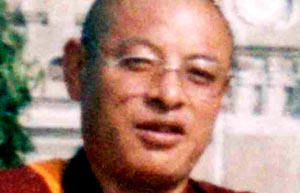
Sonam Wangyal, a respected religious figure in his local area, died shortly after setting himself on fire in the morning of January 8th.
On Friday (January 6) two Tibetans self-immolated in Ngaba (Chinese: Aba), as confirmed by Xinhua, Chinese state media. According to information from Tibetan exile sources, two Tibetans, Tsultrim and Tennyi, both around 20 years of age, set themselves on fire in the courtyard of a hotel in the center of Ngaba town and ran into the street shouting “His Holiness the Dalai Lama must return to Tibet” and “May His Holiness the Dalai Lama live for 10,000 years!” Tennyi, who is believed to be a monk from Kirti monastery, died on January 6, and Tsultrim, a lay person who may have been a former Kirti monk, died on January 7, according to the same sources.
In another development, a former monk called Norbu Damdrul who had self-immolated on October 15, 2011, died in a hospital in Barkham (Chinese: Maerkang) county, Ngaba on January 5, according to exiled Tibetan sources. Nineteen-year old Norbu Damdrul had been observed being kicked by police after the flames around his body were extinguished, but was still alive when he was taken away from the scene. His whereabouts had been unknown since his protest last year.
A respected religious figure self-immolates
Sonam Wangyal, a respected religious figure in his local area, drank kerosene and set himself on fire in the morning of January 8, in Darlag county, Golog (Chinese: Guoluo) Tibetan Autonomous Prefecture, Qinghai province (the Tibetan area of Amdo). He died shortly afterwards. The self-immolation in Golog significantly broadens the geographical spread of the Tibetan self-immolations into Qinghai, Sichuan, and the Tibet Autonomous Region. (Self-Immolation Fact Sheet).
According to a source from Tibet speaking to the Tibetan-language service of Radio Free Asia (RFA), “Before he set himself on fire at around 6 a.m., he drank and threw kerosene all over his body. His body exploded in pieces [and the remains were] taken away by police” (RFA, Angry Tibetans parade corpse – 8 January 2012). RFA additionally reported that before Sonam Wangyal self-immolated, he climbed a local hill to burn incense and pray, and then distributed leaflets saying he would act “not for his personal glory but for Tibet and the happiness of Tibetans.”
Details of the local response to the self-immolation are unclear. The Tibetan exile government in Dharamsala, India, reported that hundreds of local Tibetans staged a candlelight vigil urging the authorities to release his body. The Tibet exile government said that the “local Police averted further tension by agreeing to do so.” (Central Tibetan Administration, Self-immolator Prompts Candle Light Vigil by 2000 Nomads in Tibet – 9 January 2012). A source told RFA that Tibetans had marched to the police station in force to demand the body’s release. (RFA, Angry Tibetans parade corpse – 8 January 2012).
Two former Kirti monks die after self-immolations
The Chinese state news agency Xinhua confirmed that two self-immolations by former monks had taken place on Friday (January 6) in Ngaba Tibetan and Qiang Autonomous Prefecture, Sichuan province (the Tibetan area of Amdo). Xinhua reported on January 8 that: “A 22-year-old man set himself ablaze at around 1:00 p.m. at a crossroad in Aba county in the Aba Tibetan-Qiang Autonomous Prefecture. Police rushed to put the fire out and sent him to a local hospital, said a spokesman for the county’s government. Another man, who was identified to be 18-year-old, died of self-immolation in a hotel room not far from the crossroad later.”
The Xinhua report reflected an official Chinese approach to both discredit Tibetans who carry out self-immolations and deflect attention from government policies, citing a Tibetologist based at the Sichuan Tibetology Research Center as saying that the recent self-immolations had been carried out by “people who previously had got punished for their wrongdoings such as whoring, gambling and burglary, or deep in debt because of gambling.” (Xinhua, 8 January 2012).
Mary Beth Markey, President of the International Campaign for Tibet, said: “This deeply distressing news from Tibet must prompt the international community, which has an obligation in such extreme cases, to compel the Chinese government to address the grievances provoking so many Tibetans to take their own lives.”

